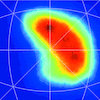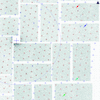issue contents
January 2018 issue

editorial
MATERIALS | COMPUTATION
The growing complexity of functional materials and the major challenges this poses to structural science are discussed. The diversity of structural materials science and the contributions that computation is making to the field are highlighted.
scientific commentaries
BIOLOGY | MEDICINE
Investigations of the rapid enzyme carbonic anhydrase have now been extended by crystallographic analysis at high CO2 pressures to examine the movements of water molecules in different steps of the catalysis. The rate of catalysis seems well explained by the assembled observations.
research papers
CHEMISTRY | CRYSTENG
Neutron powder diffraction from D-alanine, a D-form amino acid present in higher animals including humans, shows subtle structural differences when compared with its enantiomer, L-alanine. These dissimilarities are due to different rearrangements of the NH3+ group as revealed by Raman scattering.
CHEMISTRY | CRYSTENG
Download citation


Download citation


The possibility of converting crystal engineering principles that originate in the organic solid state into productive strategies for the effective supramolecular assembly of coordination complexes has been established through a range of complementary techniques. Calculated molecular electrostatic potentials, in conjunction with a systematic structural study, demonstrate that the existence and structural importance of the key hydrogen-bond interactions are not disrupted by the presence of metal cations and charge-balancing anions.
PHYSICS | FELS
The observation of O2 in a time-frozen structure using serial femtosecond rotation crystallography of the as-isolated oxidized enzyme provides long-awaited clear-cut evidence for the mode of O2 binding in CuNiRs. This provides an insight into how CuNiR from A. xylosoxidans can function as an oxidase, reducing O2 to H2O2, or as a superoxide dismutase (SOD) since it was shown to have ∼56% of the dismutase activity of the bovine SOD enzyme some two decades ago.
CHEMISTRY | CRYSTENG
Download citation


Download citation


Anisotropic atomic displacement parameters obtained separately from highly accurate X-ray and neutron diffraction data are compared, and it is established that Hirshfeld atom refinement of X-ray data can provide structural parameters that are as accurate as those from neutron data.
CHEMISTRY | CRYSTENG
Download citation


Download citation


The complexation of an NO2S2 macrocycle with CdI2 offers an opportunity to identify the kinetic and thermodynamic products via visual methods because the direct observation and structural characterization of each product were available from sequential snapshots, single-crystal X-ray structures and powder X-ray diffraction patterns.
MATERIALS | COMPUTATION
Mn50Ni42−xCoxSn8 melt-spun ribbons exhibit strong magnetostructural coupling over a wide temperature range from 222 to 355 K. The ΔSMpeak and RCeff in Mn50Ni42−xCoxSn8 melt-spun ribbons are comparable with or even superior to those of Ni-rich Ni–Mn-based polycrystalline bulk alloys.
MATERIALS | COMPUTATION
Atomic vacancies in complex crystals can be determined by atomic-resolution strain mapping at picometre precision using scanning transmission electron microscopy. The method is applied to InAs/GaSb superlattices.
MATERIALS | COMPUTATION
Using neutron total scattering and pair distribution function analysis, this work discusses how the complex local structure in lead zirconate titanate affects the long-range average structure across the morphotropic phase boundary, and its influence on the unique piezoelectric properties.
BIOLOGY | MEDICINE
The crystal structure of a bacterial 1-Cys peroxiredoxin has been solved, revealing an oligomeric interface.
BIOLOGY | MEDICINE
Ultrahigh-resolution crystallographic structures of human carbonic anhydrase II (hCA II) cryocooled under CO2 pressures of 7.0 and 2.5 atm are presented. The structures reveal new intermediate solvent states of hCA II that provide crystallographic snapshots during restoration of the proton-transfer water network in the active site.
PHYSICS | FELS
The resolution limit of serial diffraction from two-dimensional crystals at a free-electron laser was extended to the detector edge (4 Å) by exploiting the large redundancy of the data set.



 journal menu
journal menu




 access
access
























